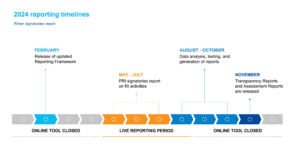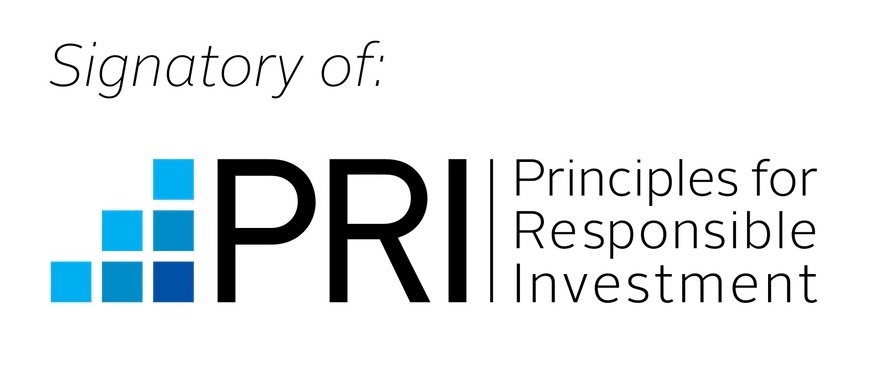After the return of the Principles for Responsible Investment (PRI) Reporting process in 2023, there are once again changes to be aware of ahead of the 2024 Transparency Reporting period. For more information on the changes made in 2023, please see last year’s summary.
To support Signatories in their efforts, Silver’s ESG Team has compiled a practical guide for Signatories to help prepare them for 2024 Transparency Reporting. In addition, Silver is hosting a webinar with PRI on Wednesday, April 17th at 9:00 am EST to discuss the reporting framework, new PRI initiatives, and how to navigate Signatory resources – read more and register here!
Who Must Report
In December 2023, the departing Chair of the PRI Board of Directors, Martin Skancke, announced in his final letter to Signatories that the Board agreed to make Transparency reporting voluntary in 2024 for certain Signatories. The PRI followed this announcement with updated guidance in January.
The breakdown of mandatory and voluntary reporters is as follows:
Mandatory Reporters
- Any Signatory whose grace period occurred during the 2023 Reporting cycle, and elected not to complete voluntary reporting
- Any Signatory whose grace period occurred during the 2023 Reporting cycle, and elected to report, but kept its responses private (determined based on responses to OO31)
- Any Signatory who reported during the 2023 Reporting cycle, but failed to meet the PRI’s Minimum Requirements
Voluntary Reporters
- Any Signatory who remains in their grace period
- Any Signatory who reported publicly during the 2023 Reporting cycle
PRI sent confirmation of each Signatory’s reporting status (mandatory or voluntary) to all reporting contacts in early March 2024. If you are unsure of your organization’s reporting status, we recommend reaching out to your Signatory Relations contact or the Reporting and Assessments team.
Reporting Timeline
PRI announced on April 2, 2024, that the 2024 reporting cycle will open on May 2, 2024 and will close on July 26, 2024.
Signatories should pay close attention to future communications from PRI related to shifts and changes to the reporting window. PRI receives but does not often grant exceptions for Signatories who request reporting extensions. For internal teams managing the reporting submission, we encourage you to understand the summer calendar and plan now for managing the internal sign-off and approval process.

Image Source: PRI Reporting 2024 Overview and Structure Guide, pg. 10
Four Steps to Ensuring Successful and Timely Submissions
Step 1: Assess Changes
Signatories should begin their process for 2024 reporting with a review of relevant changes that have occurred since the previous reporting cycle. Key items to assess include:
- Reporting status
Know whether you are required to report, or if your reporting effort is voluntary for 2024 (see above for information on a Signatory’s reporting status).
For many Signatories, reporting is voluntary. However, due to investor pressure, peer analysis, or other formal commitment, these organizations may choose to participate in the 2024 Transparency Reporting cycle. If your organization is not obligated to report in 2024, we encourage you to maintain your rationale for either participating or opting out of the reporting effort.
- How the PRI Reporting and Assessment (R&A) Frameworks have changed
PRI has released several resources designed to guide Signatories through changes to the R&A Frameworks. These resources include an Overview and Structure Guide, Reporting Glossary, and the 2024 Reporting Modules themselves. The overall framework has not been meaningfully altered from 2023, however there are a few changes in logic that will alter the indicators that populate for certain Signatories. Please see the 2024 Update and Changes Guide for more information.
- How a Signatory’s Responsible Investment practices have changed
In addition to assessing how PRI’s methodology has changed, it is key for Signatories to take stock of how their internal ESG processes have changed. Relevant topics to consider include:
-
- Changes to a Firm’s asset class exposure or investment strategy
- Responsible Investment Policy updates, amendments, or alterations
- Evolution of stewardship and engagement practices
- Governance changes, including the role of any dedicated personnel or decision-making bodies, such as a Responsible Investment Committee
- Approach to climate-related risk and opportunity
- Audit or other third-party verification of Responsible Investment reporting and practices
- For Signatories who choose not to report
For Signatories who were notified of their voluntary reporting status for 2024, it is still considered good practice to determine how your responsible investment program has changed over the past year, and to maintain an understanding of how future disclosures to PRI will be impacted by these changes.
Step 2: Determine Approach to 2024 Framework
Next, Signatories should work to establish baseline responses to the 2024 PRI Reporting Framework. This process has three distinct phases:
- Understand applicable modules:
-
- PRI Signatories must report to a set of required modules, which include the Senior Leadership Statement (SLS), Organizational Overview (OO), PGS, and CBM.
- Additionally, asset manager Signatories must determine the specific asset class modules they will be required to complete.
- An asset class module is required to be completed if the Signatory has greater than 10% of their AUM or greater than $10 billion USD in the respective asset class. (Exceptions apply, please refer to the PRI Logic guide for more information).
- Reminder: Signatories should carefully review their AUM attributable to different asset classes; many organizations are close to meeting the threshold for reporting for additional asset class modules. Signatories should not assume their required modules will be unchanged.
- 2. Review previous responses:
-
- For Signatories that reported in 2023, comparing 2023 responses to the 2024 Reporting Framework is integral to establishing baseline 2024 responses. PRI has provided a ‘pre-fill’ option via the Reporting portal to aid Signatories in their understanding of previously-populated responses.
- Reminder: We recommend Signatories do not rely entirely on the ‘pre-fill’ option; all responses should be reviewed and agreed to ahead of submission, even if no changes have occurred in a Signatory’s processes or policies.
- 3. Use of offline modules:
-
- The final step is to fill in the relevant reporting modules. The PRI has provided both Word and PDF versions of offline modules to facilitate this process.
- Reminder: We encourage Signatories to use the offline modules to determine the full scope of reporting requirements.
PRI has released several additional guidance documents that may be useful in this process, including a video on 2024 reporting, minimum requirements reporting guidance, and guidance on human rights reporting.
Silver encourages Signatories to continuously monitor the Reporting and Assessments Updates page for reporting-related news from the PRI.
Step 3: Establish Rationale, Manage Data Entry, and Prepare for Final Review
Once baseline responses have been established, Silver views the following best practices as imperative in submitting complete, timely, and defensible Transparency Reports:
- Establish rationale:
- We continue to identify the lack of documentation and rationale for responses included in a Signatory’s past Transparency Reports as a common failure.
- Once a Signatory has selected its responses, it is critical to ensure that appropriate documentation and rationale is maintained to support the firm’s approach, and any interpretation taken. This practice will help a firm avoid unnecessary regulatory scrutiny, especially in the event its reports are part of a routine SEC exam, or similar (and we also expect this effort to facilitate reporting in future cycles!).
- Manage data entry:
- While PRI has made offline modules available since late January 2024, the online Reporting Tool, which Signatories must use to submit their official reports, will not open until May 2.
- Beginning the reporting process prior to the reporting tool opening is vital to ensuring that a Signatory can complete timely submission of its PRI Transparency Report. In 2023, many Signatories experienced technical issues attempting to enter data in the final weeks of the Reporting process – start early to avoid known and unknown impediments!
- Prepare for final review:
- Once data has been added to the Reporting Tool, the final step before submission should be an organizational review of the completed PRI Report.
- In Silver’s view, it is key for relevant Responsible Investment, investment, compliance, legal, and management personnel to review the submission file. A Signatory’s Transparency Report is publicly available and should be reviewed through a regulatory lens. Signatories should ensure that the answers provided in the CBM module with respect to submission review match its final review efforts.
Step 4: Understanding Assessment
As a reminder, only the PGS, asset-class, and CBM modules are assessed by PRI. SLS and OO are not assessed. Signatories with Listed Equity and Fixed Income assets will receive separate scores for each relevant sub-asset class category.
PRI has confirmed that the five-star scoring framework, first implemented for the 2021 R&A process, will continue into 2024. The score ranges associated with each star remained consistent in both 2021 and 2023; however, PRI has not guaranteed that this will continue to be used.
New and Enhanced Initiatives from PRI
Progression Pathways
- The Progression Pathways, currently being developed by PRI in collaboration with Signatories, aim to provide tailored support and guidance to Signatories at different stages of responsible investment practice. The pathways are framed by three responsible investment objectives: incorporating ESG factors, addressing the drivers of sustainability-related financial risks, and pursuing positive impact. Through a co-design process, these pathways will evolve to meet the diverse needs of Signatories and help them develop and progress their responsible investment practices.
- Details related to the shape and scope of the Progression Pathways are being released on a rolling basis, and are in the early stages of design and development. While it is anticipated that these pathways will affect reporting in the future, that assessment will need to be made when more information is available.
SPRING
- SPRING is PRI’s newest stewardship initiative, focused on combating biodiversity loss through responsible political engagement practices. SPRING aligns with the goals and aims of the Global Biodiversity Framework to engage companies in shaping public policies, endorsing urgent action, setting targets, and adopting sustainable practices to address nature-related risks and opportunities. The initiative currently has 144 investor endorsements, totaling $9.8 trillion in assets managed.
Expanded use of the Collaboration Platform
- The PRI Collaboration Platform is a forum where PRI Signatories can collaborate, share resources, and improve their impact on ESG issues. The forum connects investors and academics, allowing them to exchange ideas and engage in research opportunities. Signatories can initiate collaborative engagements, share joint investor statements, propose research projects, engage with policymakers, request support for shareholder resolutions, and participate in group discussions. PRI is expected to continue to focus its efforts on the collaboration tool in the near term.
Silver’s PRI Support Services: Silver partners with PRI Signatories in a variety of ways, including conducting PRI gap analyses for new or prospective Signatories and providing support and guidance during the Transparency Reporting cycle. Silver also undertakes reviews of internally completed Transparency Reports for Signatories seeking third party evaluation. Silver’s PRI Signatory clients currently represent over $750 billion of combined AUM.
Please reach out to a member of Silver’s ESG Team at [email protected] to learn how we can support you prepare, report, and implement enhancements as part of the 2024 Transparency Reporting cycle.


